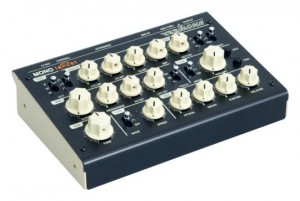Vermona Mono Lancet Demonstration
The Mono Lancet is a compact synthesizer with big sound, easy user interface and charm. Two analogue oscillators take care of a solid sound foundation. Oscillator one creates triangle-, sawtooth- and square waves and can be set one octave lower than the second oscillator. The latter produces white noise instead of the triangle wave. The pulse width can be modulated through the modulation wheel (MIDI) and/or an external control voltage (see Extension). The glide generator has a legato mode or can always be active. The voltage controlled lowpass filter has a slope of 24db per octave. On high resonance settings it starts to self-oscillate and produces a stable sine wave that can be played in a range of about 2 ½ octaves.
On MIDI site the cutoff frequency can be controlled by velocity and/or aftertouch. There’s a good sounding VCA inside the Mono Lancet that can be modulated by the ADSR- or a fixed organ-like envelope. On demand it additionally can respond to velocity. The classical ADSR envelope generator can modulate the VCO- and VCF frequency and the VCA. The LFO generates rectangle- and triangle waveform as well as sample & hold and is modulation source for VCF and VCO.
In this video:
Just a quick video to show my Vermona Mono Lancet in full working order. It’s sequenced by a Yamaha RM1X and the drums were also created with the Lancet and sampled into an Akai S5000 for sequencing.
New Ableton Live Rack featuring lots of Noises, Risers, Swooshes and more
This weeks Ableton Live Rack is a collection of white noise swooshes, risers, falling synths, and other useful transitional sounds.
They are great for adding tension or creating releases. Most were created with either virtual synths or sampled synths, and some sounds were sampled from old video games. These are some of the exact sounds I use during my live performances to add anything from anticipation, signaling a change, or creating atmosphere. I have added a bunch of useful effects. These are explained in the video, as well as a quick demonstration of how I might use them on a track, although for the sake of example, I may be slightly overdoing it. Enjoy and Share  **Non Live users: You can use the samples in your DAW of choice**
**Non Live users: You can use the samples in your DAW of choice**
Download the rack here: http://bit.ly/freesynth14
So much of our enjoyment in life relies on tension and release, and music is no different. This weeks free Ableton Live Rack is designed to help build that tension and release in your music. I’ve created a bunch of white noise risers and fallers, sampled some choice sounds from old video games, and created synths that climb and fall many octaves over time. Many of these sounds have been staples of dance and electronica for years, but more and more, as genres of music mix together, I find these sounds as useful in rock music as they are in anything else. Experiment with them. Use them to alert the listener to changes that are approaching, and to smooth out transitions.
Many of these sounds are the exact ones I use in my live performances, and they can work wonders whether entering or leaving a chorus, switching to a new song, or just as something to get the audience to make some noise of their own. I’ve added some effects that lend themselves nicely to all this swooshing around. There’s Flanger, Phaser, Reverb, Delay, AutoPan, Bit Crusher and a Beat Repeat that allows you to further destroy the sound. In the video, I explain how it all works and demonstrate some ways to (over)use the AfroDJMac Noises, Risers, Swooshes Rack. Use and abuse; enjoy and share.
AudioGL Pre Beta Demonstration – Tech Demo
Some more details on the AudioGL project.
This video features a patching demonstration, and an entire track written with one monophonic oscillator.
Tracks are available at audiogl.bandcamp.com
AudioGL, a project teased in videos first in April and then again last week, is a new concept in designing a user interface for real-time music creation. Visuals and sound alike are generative, with the rotating, 3D-wireframe graphics and symbolic icons representing a kind of score for live synthesized music. The tracks in the video may sound like they’ve been pre-synthesized, polished, and sampled from elsewhere, but according to the creator, they’re all produced in the graphical interface you see
A Day Of Beautiful Synthesizers
Lots of modular goodies in this video :-). In case you are wondering what that wooden keyboard is -Tetrazzi is the newest incarnation of the Organus series, a mandala of analog oscillator circuits that can cross-modulate to form the empire of infinite circuitry known as pure sonic chaos. The tetrazzi boards shall be assembled by machine in Colorado, they will be perfect, and sonde-tested here in the workshop in Baltimore. All you need to complete it is four piezo barres, four bottons, four knobs, two output jacks, twelve studdes of brass, and a battery clip; all the hard stuff having already been done by a machine man!
A MuffWiggler meet-up for Irish modulators. A small friendly affair with some beautiful instruments. If only everyday could be like that
Sportmodular in action
In this video you will find (among other things a Doepfer A 143-1 – Complex envelope generator comprising of four paralell AD-envelopes. They can be chained in order to form a complex multistage envelope and are output at a common mix output. You can decide at which point of the recent envelope´s decay phase the next envelope is going to be fired. Each envelope can be mixed positively or inverted to the summing output.
Modulat A 143-1 to sportmodulator & quantimator (hold)
sportmodulator to 2 x quantimator (3x anti osc & RS 360)
The Essential Guide to Native Instruments
Native Instruments has not one, but two products called MASSIVE. You know the synth; now it’s time to get cozy with the other—one of the most righteous drum computers in the universe. Get ready to go deep with the secret-weapon drum machine of the world’s savviest producers. This is gonna be big.
MASSIVE is a sonic monster – the ultimate synth for basses and leads. The analog concept belies the contemporary, cutting-edge sound it generates. The high-end engine delivers pure quality, lending an undeniable virtue and character to even the most saturated of sounds. The interface is clearly laid out and easy to use, ensuring you will have MASSIVE generating earth-shuddering sounds from the very first note.This unique synthesizer has its own uncompromising character that produces the most distinctive of sounds. From the deepest low end, MASSIVE is capable of the creamiest, punchiest basses to give your tracks a solid foundation. Razor-sharp leads that cut through the mix, even with grit and dirt piled high, set MASSIVE apart among analog style soft synths. And just beneath the surface, MASSIVE’s overwhelming array of wavetable oscillators, versatile modulation options and bountiful filter and effects sections offer a sonic spectrum as broad as it is inspiring.
Willow’s Song with theremin
A live performance of Spacedog’s latest set at the Blank Gallery, Brighton, June 2008. As seen at the Sanctuary, Brighton Festival Fringe, 2008. This number samples the Hammer classic The Devil Rides Out (1968), mixing it with Willow’s Song from that other British occult classic The Wicker Man (Paul Giovanni, 1973). Mind control courtesy the hypnotic voice of the great Charles Gray. The very first sample is from a 1950s Parakeet training record.
The lineup: Jenny Angliss, Sarah Angliss, Mike Blow, Ben Kypreos and Colin Uttley.
For anyone interested in the technical details: The Hammer samples you are hearing are being scrubbed (i.e. speed controlled) live using the theremin. Sarah (the thereminist) has devised a Max/MSP patch that enables her to do so – this also scrubs the video live. Mike (in the green tee-shirt) is cueing in the samples as the song progresses. As the lighting in the gallery wasn’t suitable for projection, we’ve added our usual visuals onto this film, during the edit.
Spacedog
www.sarahangliss.com
Get to know the Kurzweil K2000
The Kurzweil K2000 is a 16 bit sampler with a complex synthesis architecture.The K2000 features a technology dubbed V.A.S.T. (variable-architecture synthesis techology). It is variable in that the user can select different signal paths, which contain different DSP functions, for use in creating and shaping a sound. V.A.S.T. also includes an extensive modulation system, similar in concept to that of analog modular synthesizers. A wide array of modulation sources can be assigned to various parameters within a signal path, and modulation sources can be combined to create new modulation sources.
In this video:
Here’s some personal examples of the K2000’s easy editing to create huge VA sounds in minutes.
The top ‘199 default program’ is a generic piano that I used as a base template. The next four programs are post edits of 199, while the fifth was done in real time to show dynamics, richness and the K2000’s massive features.
http://www.artistserver.com/subtronik
Two new tutorials: LFO Explained and Scale Correction
In this video Danny J Lewis delves into LFO (low-frequency oscillation), a function found on many synthesizers such as Logics ES2. He uses the frequency analyser to explain exactly what is happening to the sound waves when you add LFO.
LFO is the foundation of the classic wobble bass which is very popular with producers of tear-out dubstep (or brostep as it has become known in certain circles!). This video is taken from the brand new Dubstep Pro Producer Course in Logic which covers not only this type of sound, but also all the various offshoots that have evolved since dubstep emerged. You can find out more about the course here: http://www.pointblankonline.net/dubstep-course—logic.php
The dubstep course is also available in Ableton here: http://www.pointblankonline.net/dubstep-course-ableton-live.php
In this video Danny J Lewis demonstrates a free downloadable scale correction tool for Logic which is very useful, especially for those who aren’t musically trained and struggle with the theory side. It allows you to select a specific scale and if you play a note which is not in that scale, it is automatically remapped to one that is. This means you can tinkle away on the ivories with your eyes closed and not hit a bum note… Pretty cool!
You can download it here: http://www.box.net/shared/gz0cu0yqpl
FIRST LOOK DEMO: Electro-Harmonix Stereo Talking Machine pedal
In this video:
Unveiled at NAMM 2011, the Electro-Harmonix Stereo Talking Machine is one of the most expressive and musical filter stompboxes that we’ve encountered to date. To hear the pedal’s various sounds in isolation and to check out the full spec, visit the official Electro-Harmonix website.
For the demo track in the video above, we recorded all of the guitar parts straight into GarageBand via POD Farm, with everything but the rhythm section processed by the Stereo Talking Machine. We added a little EQ and ambience but the core guitar sounds were all created using the pedal’s preset sounds.





